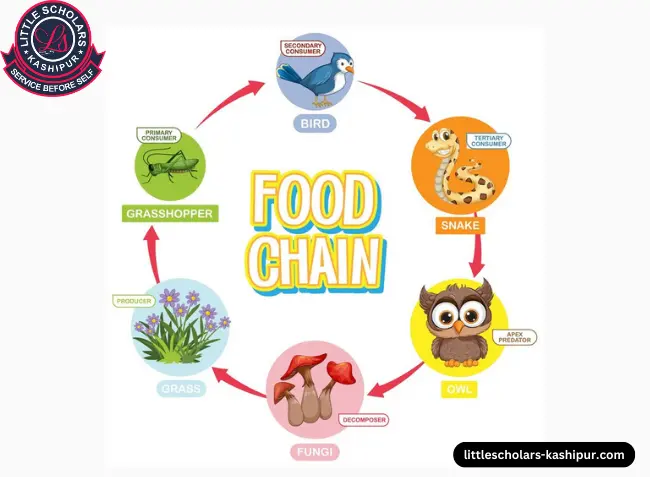Have you ever wondered how energy flows in an ecosystem or why certain animals prey on others? It all boils down to something called a food chain. Food chains are vital for the balance of our ecosystems, helping to transfer energy from one organism to another. In this article, we will delve into the intricacies of food chains, why they matter, and how they impact our world.
The Basics of Food Chains
What is a food chain?
A food chain is a linear series that illustrates the transfer of nutrients and energy between organisms within an ecosystem. It starts with primary producers and moves up through various levels of consumers.
Trophic Levels Explained
Trophic levels are the different stages in a food chain, categorized by how organisms obtain their energy. They range from primary producers at the bottom to apex predators at the top.
Types of Food Chains
Grazing Food Chain
The grazing food chain begins with green plants, which are consumed by herbivores, and continues up to carnivores that eat the herbivores.
Detritus Food Chain
In contrast, the detritus food chain starts with dead organic matter, which is broken down by decomposers like bacteria and fungi, followed by detritivores and other organisms.
Trophic Levels in Detail
Primary Producers
These are usually plants and algae that convert sunlight into energy through photosynthesis. They serve as the food chain's base.
Primary Consumers
Herbivores that eat primary producers. Examples include rabbits and caterpillars.
Secondary Consumers
Carnivores that prey on primary consumers. Think of frogs and small fish.
Tertiary Consumers
These are larger predators that eat secondary consumers. Hawks and large fish are typical examples.
Quaternary Consumers
Apex predators at the top of the food chain, such as lions and killer whales,.
Energy Flow in Food Chains
How Energy is Transferred
Energy in a food chain is transferred from one trophic level to the next. However, only about 10% of the energy at each level is passed on; the rest is lost as heat.
The 10% Energy Rule
This rule highlights the inefficiency of energy transfer in ecosystems. For instance, if a plant captures 1000 calories of energy, only about 100 calories will be available to the herbivore that eats it.
The Role of Decomposers
importance of Decomposers
Decomposers play a crucial role in breaking down dead matter and recycling nutrients back into the ecosystem, ensuring the continuity of the food chain.
Examples of Decomposers
Bacteria, fungi, and earthworms are all key decomposers that help maintain the health of ecosystems.
Food Webs vs. Food Chains
Differences Between Food Chains and Food Webs
While a food chain is a single pathway of energy flow, a food web consists of multiple interconnected food chains, providing a more realistic representation of energy flow in an ecosystem.
Why Food Webs Are More Realistic
Food webs illustrate the complex interdependencies between organisms, showing how energy and nutrients circulate in multiple directions.
Examples of Food Chains
Terrestrial Food Chain Example
A simple terrestrial food chain could be grass → rabbit → fox. Grass (primary producer) is eaten by a rabbit (primary consumer), which is then preyed upon by a fox (secondary consumer).
Aquatic Food Chain Example
An aquatic example might be phytoplankton → small fish → larger fish → shark. Here, phytoplankton (primary producer) is consumed by small fish (primary consumer), which is eaten by larger fish (secondary consumer), and then a shark (tertiary consumer).
Human Impact on Food Chains
Pollution
Pollutants can disrupt food chains by contaminating water and soil, affecting all trophic levels.
Overfishing
Overfishing removes key species from marine food chains, leading to imbalances and the collapse of ecosystems.
Habitat Destruction
Deforestation and urbanization destroy habitats, which can lead to the extinction of species and disrupt existing food chains.
Conservation and Food Chains
Importance of Preserving Food Chains
Maintaining healthy food chains is vital for biodiversity and the stability of ecosystems.
Efforts in Conservation
Conservation efforts include protecting natural habitats, restoring damaged ecosystems, and implementing sustainable practices to ensure the balance of food chains.
Case Study: The Yellowstone National Park
Reintroduction of Wolves
In the 1990s, wolves were reintroduced to Yellowstone after being absent for decades. This reintroduction had a profound effect on the park's food chain.
Impact on the Food Chain
The presence of wolves controlled the population of deer, which allowed vegetation to recover. This recovery benefited other species, demonstrating the complex interdependence within food chains.
Exploring the Wonders of Biodiversity Hotspots: Preserving Nature's Treasures: Read more
The Future of Food Chains
Climate Change Implications
Climate change alters habitats and the availability of resources, affecting all levels of the food chain.
Sustainable Practices
Adopting sustainable practices, such as reducing waste and protecting natural habitats, can help mitigate the impact on food chains.
How to Teach Kids About Food Chains
Fun Activities and Games
Activities like food chain puzzles and interactive games can make learning about food chains fun and engaging for kids.
Educational Resources
Books, documentaries, and online resources can provide valuable information to help children understand the importance of food chains.
Misconceptions About Food Chains
Common Myths Debunked
One common myth is that all food chains are simple and linear. They are actually intricately linked and multifaceted.
Discover Environmental Studies: Connecting with Nature: Read more
Conclusion
Food chains are the backbone of ecosystems, illustrating the flow of energy and nutrients. Understanding them helps us appreciate the delicate balance of nature and the importance of each organism within it. By preserving food chains, we ensure the health and sustainability of our environment.




